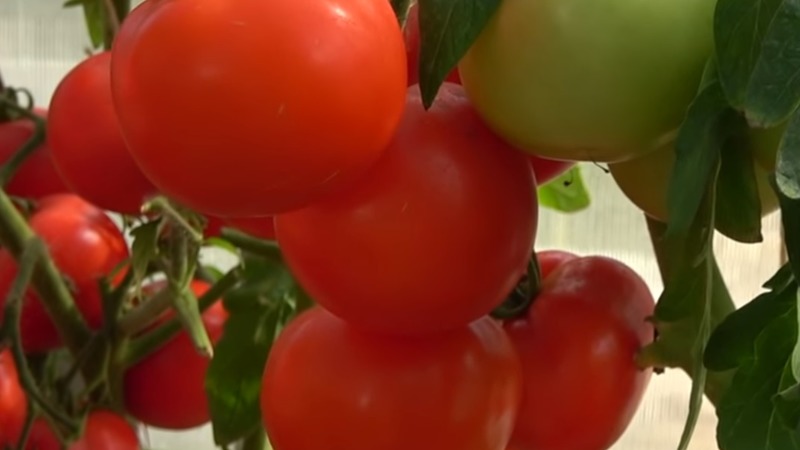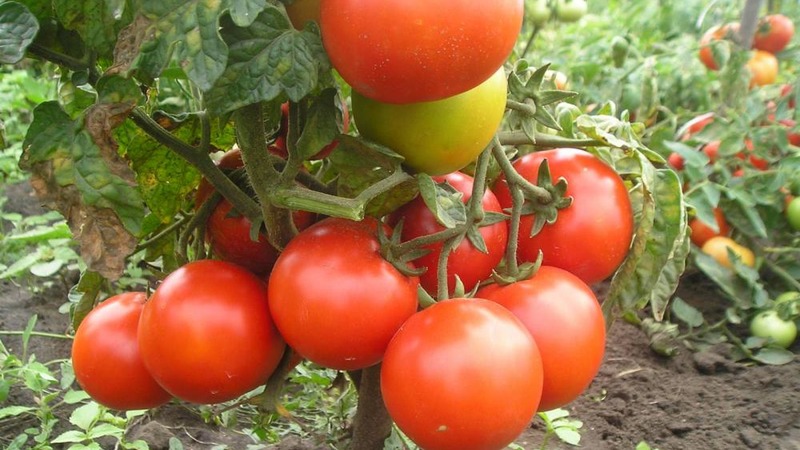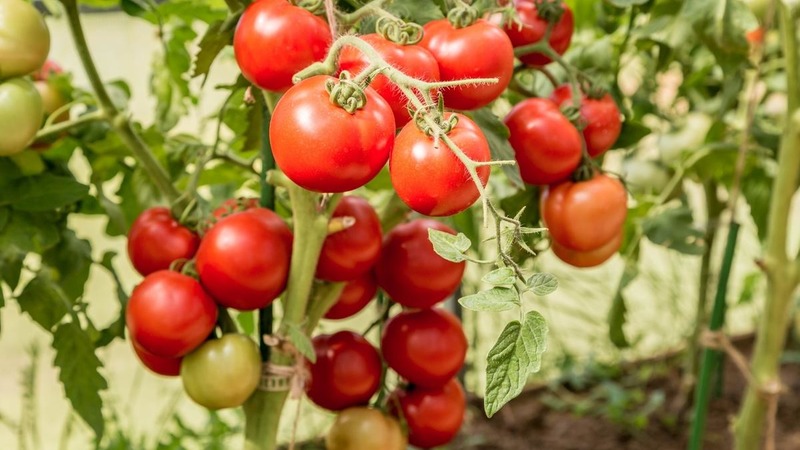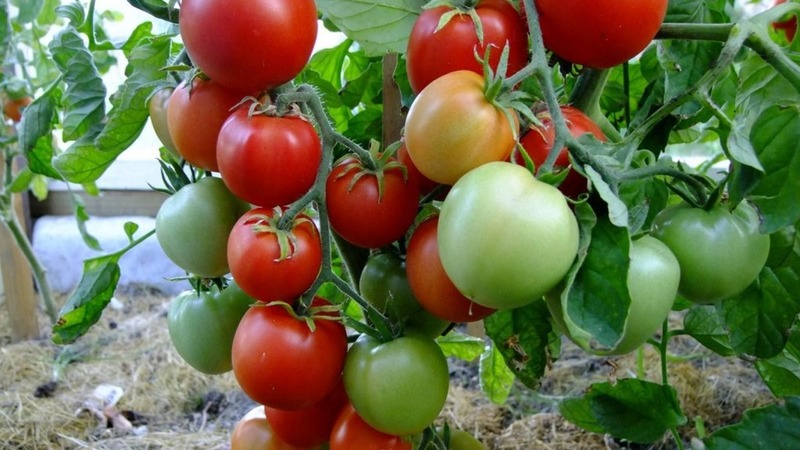One of the best early ripening and unpretentious varieties - tomato "Lyubasha f1": yield and characteristics
The review of the new hybrid tomato Lyubasha will acquaint you with the characteristics and description of the variety, reveal the secrets of yield, present photos and reviews for illustrative examples. Opinions about the variety of those who planted indicate a high rate of fruiting, ease of care, resistance to disease and excellent taste of the fruit. Despite its short existence in the tomato world, the variety won over many vegetable growers, for whom Lyubasha is a welcome guest on the garden plot.
The content of the article
Description of the variety
Tomato Lyubasha f1 was bred by breeders of the "Partner" company in 2016. Included in the State Register in 2017. Recommended for cultivation in all regions of the country in protected and unprotected soil.
Bush determinant, height 1 m, compact. Leaves are medium, small, bright green. The inflorescences are simple. The first inflorescence is laid above 5-6 leaves. The brush sets up to 8 fruits.
Ultra-early ripe hybrid: 65-75 days pass from the moment of germination to full maturation.
The yield is high, up to 5 kg of vegetables are harvested from one bush, provided that 4-6 bushes are planted per 1 sq. m.
Resistant to the main diseases of the nightshade family.
Despite the short stature and compactness, the plants require a garter and pinching.
Fruits are rounded, slightly flattened. The color is bright red. Not prone to cracking in cold or rainy weather. Seed chambers 3 - 4, few seeds. The rind is dense. Weight 120-150 g.
They are versatile in use: suitable for fresh consumption, for whole-fruit preservation, for the manufacture of tomato products: juices, pastes, ketchups, lecho. They are good in pickling and pickling. They do not lose their delicious taste when dried.
Ripe vegetables are subject to long-term storage and can withstand long-term transportation.

How to grow seedlings
Sowing of seeds occurs 55-60 days before planting seedlings in the ground. Potting soil is prepared from garden soil by mixing it with peat and compost. If possible add ash.
Reference! If the garden soil contains clay, it must be mixed with washed river sand or sawdust. This technique will make the ground loose, which will facilitate better air penetration into the soil.
The prepared soil is disinfected with a solution potassium permanganate... Then the seed is disinfected. For this, the grains are placed in a weak solution of manganese or in a solution of Fitosporin for 20 minutes.
You can plant in a common wooden box or in individual peat pots and plastic cups. The main thing is to make drainage holes in the landing container in order to exclude stagnant water.
Important! To improve germination, the seeds are placed in a growth stimulator for 5 hours.
The seeds are sown in a slightly moist soil with a distance of 2-3 cm between them. The seeded containers are covered with foil or glass and left in a room where the air temperature is at least 23 degrees.
The first shoots can be seen on days 4-7. When sprouts appear, it is necessary to immediately rearrange the containers to the light. Otherwise, the bushes will stretch and weaken.
The soil is kept moist, watering it only with settled and warm water.
The optimal daylight hours for seedlings are at least 12 hours a day. If daylight is not enough, artificial lighting lamps are used as additional illumination.
At the stage of seedling growth, the hybrid does not need feeding.
When 3 real leaves appear, a pick is made. During the picking, the seedlings are seated in looser boxes, with a distance of 20 cm between the shoots, or in a separate container.
The first two weeks after emergence, they are subjected to hardening, which consists in maintaining a lower temperature than usual. During the day, the temperature drops to 16 degrees, and at night to 13.
2 weeks before planting in the ground, the seedlings are taken out into the open air on sunny days for early adaptation to outdoor conditions.

How to grow tomatoes
After 55-60 days, the seedlings are ready for transplanting. At this time, the bushes already reach 25 cm in height, they have a strong stem, 8-9 leaves and the first flower cluster begins to form.
On the eve of planting, the soil is watered abundantly, compost and ash are laid in each hole. Fresh manure cannot be used as fertilizer for planting.
For tomato beds, choose a sunny place, unshaded, where light falls throughout the day.
For 1 sq. m 4-5 seedlings are planted. The distance between plants is 35-40 cm.
A few days later, as the sprouts become stronger, the first watering is carried out under the root with warm, settled water. Water it once a week on hot days - 2 times a week. 4-5 liters of water are consumed for each bush. The plant responds well to drip irrigation. You can also pour water into previously prepared containers located in the root zone, from where water will gradually penetrate to the roots of the plant. An ordinary plastic bottle without a bottom is suitable for this.
After watering, the soil is loosened, spud and weeds are removed. Loosening promotes the formation of additional roots. Mulching beds keep them moist longer and inhibit weed growth. Watering is stopped 2.5 weeks before harvesting vegetables.
The first feeding is carried out on the 10th day after planting. Fertilized grass in a ratio of 1:10 serves as a fertilizer. When ovaries appear, phosphorus-potassium fertilizers are added. Top dressing is carried out after watering, every 2 weeks.
Culture requires compulsory pinching. Bushes form into 2 or 3 stems. When dribbling in 2 trunks, leave the stepson under the first flower brush. When dribbling in 3 trunks, 2 stepsons are left: under the first flower brush and above it. But experienced gardeners are advised to keep bushes in 4 stems, according to their estimates, this technique contributes to maximum fruiting.
Reference! A greater number of stepchildren are left in the southern regions.
As it grows, a garter bush is required, despite the strong stems. For garters, wooden stakes, rigid trellises or twine are used. If the plant is not tied up, the fruit brushes will break under their own weight.

Diseases and pests
Lyubasha f1 tomatoes are distinguished by increased resistance to diseases, such as: top rot, tobacco mosaic, late blight. In addition, the early ripening period allows the culture not to linger for a long time in the beds, which protects it from prolonged attacks of pests.
Compliance with the rules of crop rotation and agricultural technology enhances plant immunity. And if you add preventive measures to all the rules of care, then your tomato crops will withstand even hordes of pests.
Ground pests: slugs, Colorado beetles, ticks are afraid of wormwood decoctions, garlic and bitter pepperthat scare them away with their scent. Regular inspection also reliably protects bushes from their appearance.
Digging deep before planting contributes to the destruction pestsviolating the root system. These include beetles, wireworms, bears. Tilling the soil with lime or dolomite flour also saves from their appearance.
For the prevention of fungal and bacterial diseases, biological preparations "Alirin" or "Gamair" are well suited.
The nuances of growing in open ground and in a greenhouse
The culture is equally well adapted to open ground and to greenhouse... But in a protected soil the yield is higher.
Growing in a greenhouse leads to waterlogging of the air, which is manifested by an outbreak of fungal diseases. To avoid this, regularly ventilate the greenhouse. But remember that tomatoes don't like drafts.
On the street for tomato beds, they choose a sunny place, open, but protected from strong winds. A slight breeze will prevent fungal spores from settling. In the open ground, the greatest likelihood of attacks by insect pests remains, with the exception of the spider mite, which prefers greenhouse conditions. Therefore, if the variety is planted outdoors, the main preventive measures are reduced to protecting the beds from insects.

Harvesting and application of the crop
The collection of vegetables begins from the last decade of June - early July. Ripening occurs with brushes, vegetables ripen at the same time, which greatly simplifies their collection. You can cut whole branches with fruits.
Ripe vegetables are used fresh, salted, in marinades, in the preparation of various dishes. Due to their small size, they are well suited for canning whole fruits.
Indispensable in vegetable dishes such as stews, mashed potatoes. First courses complement well: borscht, soups. Ideal for roasting with meat products and other vegetables. They are also suitable for cooking tomato products: they make delicious juice, wonderful adjika and lecho. Serve as a basis for a variety of sauces. Ripe tomatoes can even be dried thanks to their dense pulp.
This variety is intended for long-term storage without loss of taste and appearance. Delivers transportation over long distances, which makes it possible to transport ripe vegetables to other regions for sale.
Advantages and disadvantages
Any hybrid is obtained by crossing two carefully selected varieties in order to preserve their best qualities in the future generation. Therefore, speaking of a hybrid, many positive properties can be noted:
- ultra-early ripening;
- the possibility of breeding in any region;
- high resistance to diseases;
- uncomplicated agricultural technology;
- high productivity;
- ripening of fruits at the same time;
- excellent taste;
- versatility in application;
- possibility of whole-fruited canning;
- long-term storage;
- long transportation.
For all hybrids, the main drawback is the inability to independently select seeds for the next planting. Seed material will have to be purchased in specialized stores. The rest of the lack of culture are insignificant, they can be called conditional:
- required garter;
- pinching is required.

Farmers reviews
Despite its short existence, the variety managed to attract many vegetable growers. The new hybrid meets all the basic requirements and is quite capable of competing with crops that have proven themselves in the tomato world.
It is quite possible that in the near future the variety will begin to be massively used on an industrial scale, making a decent profit from this. But so far, experiments with a young hybrid are taking place in summer cottages.
Let's get acquainted with the opinions of gardeners:
Tatiana, Oryol: “The weather this year was not tomato at all, cold and rainy. Many varieties were killed by late blight, but the hybrid survived. The vegetables were delicious, now I will be with preparations all winter. It is very good that I planted this variety, otherwise I would be left without tomatoes. "
Elena, Kursk: “Quite normal grade. I did not cut it, did not water it often. But there were tomatoes. The taste is quite satisfactory, usual for tomatoes, with sourness. The skin is dense, for the blanks it is. It is a pity that the seeds cannot be prepared by yourself. Will have to buy again. Thank God the price is affordable ”.
Dinara, Krasnoyarsk:“The cultivar rose with difficulty, the bushes are modest, 2-3 fruitful clusters. But our cold summer survived. There were few vegetables. I don't even know if I'll plant him next year. "
Conclusion
The type of tomato Lyubasha f1 has established itself as a high-yielding, unpretentious in care, disease-resistant and well-adapted to open ground and greenhouse conditions. But unpretentious care does not mean a complete lack of attention to the plant.
Like any other crop, the variety needs timely feeding and watering. And if you follow the rules of crop rotation, Lyubasha will respond with a variety of delicious tomatoes that will decorate your tables both in summer and winter. The name of the variety reflects its very essence. I just want to say: nice and inexpensive.